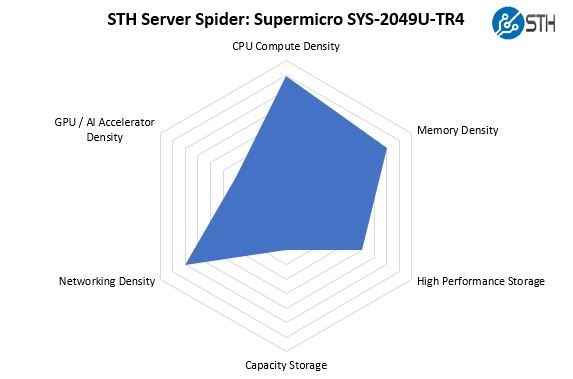Supermicro SYS-2049U-TR4 Power Consumption
This is one area that the Supermicro SYS-2049U-TR4 performed extremely well in. We saw an appreciably lower power consumption figure than with our original 4P Intel OEM test system with a similar configuration.
- Idle: 0.30kW
- STH 70% Load: 0.74kW
- 100% Load: 0.83kW
- Maximum Recorded: 0.95kW
Just the memory alone in this system is using a massive amount of power with 48x 32GB RDIMMs. On the other hand, these are better numbers than our Supermicro SuperServer 8048B-TR4FT 4P E7 V3 system showed. It is not just faster, but it uses less power which is an enormous benefit. The system also utilizes less than half the rack space and PDU ports.
Note these results were taken using a 208V Schneider Electric / APC PDU at 17.6C and 72% RH. Our testing window shown here had a +/- 0.3C and +/- 2% RH variance.
STH Server Spider: Supermicro SYS-2049U-TR4
In the second half of 2018, we introduced the STH Server Spider as a quick reference to where a server system’s aptitude lies. Our goal is to start giving a quick visual depiction of the types of parameters that a server is targeted at.

There are 2U4N solutions on the market that have twice as many CPUs per rack unit, but the Supermicro SYS-2048U-TR4 is the scale-up solution which means that this server is very dense for a single node. Supermicro also has dense storage and I/O options along with the quad Intel Xeon CPUs.
Final Words
Looking at the Supermicro SYS-2049U-TR4, it is easy to see why this is becoming a popular platform. Supermicro has expansion options that many other large vendors are not able to match. One gets 136x PCIe 3.0 lanes exposed to add-in card or drive utilization. That is enormous flexibility for a 2U quad socket server.
The real reason one purchases a 2U quad-socket server is for either scale up applications where dual socket servers are not big enough. A trend we have seen in specific geographies for more widespread 4P server adoption is driven by two cost trends:
- The ability to better utilize resources such as CPUs, memory footprint, and power supplies
- Reducing system overhead from using fewer power supplies, PDU ports, NICs, switch ports, cables, optics, chassis, and even boot drives.
Given the relative pricing, if one is using Intel Xeon Gold 5100 series or higher (best if Gold 6100 series or higher) SKUs are used, the Supermicro SYS-2049U-TR4 itself costs less than two 2U Ultra servers, which supports the theory behind #2.
Once the decision to go quad-socket in infrastructure is made, the Supermicro SYS-2049U-TR4 is an absolutely awesome package that can have real cost-saving benefits for your organization.




They maybe could have noticed that AMD has a socket called TR4 before they used that for their server designation…
Thomas Supermicro was using -TR4 since 2015 in the 2011 era https://www.supermicro.com/products/system/1U/1028/SYS-1028U-TR4_.cfm and they’ve used it on many servers.
Maybe AMD should have noticed Supermicro called Intel platforms -TR4 when they had certain specs
No worries, the prefix still will show clearly the server is AMD, AS-2124…..